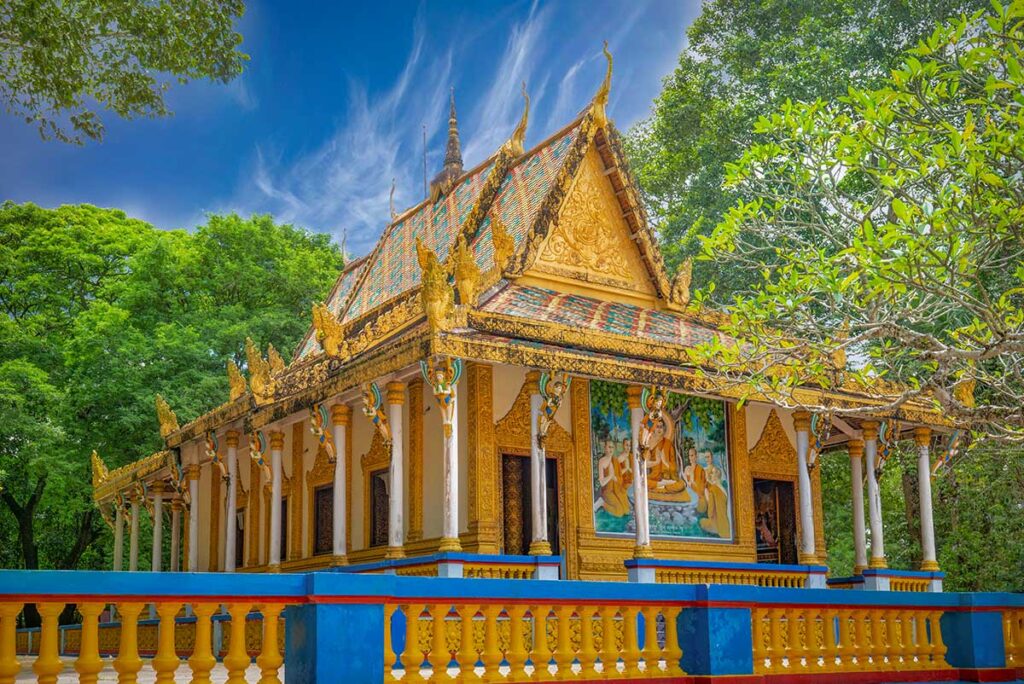What is Bat Pagoda (Chua Doi)?
Bat Pagoda, also known as Mahatup Pagoda or Chùa Mã Tộc, is located just a few kilometers from the center of Soc Trang City in the Mekong Delta. The name “Bat Pagoda” comes from the thousands of giant fruit bats that once crowded its tall trees, although their numbers have decreased in recent years. For locals, it is not only a tourist spot but also one of the most important Khmer Buddhist temples in the province.
The pagoda was originally built in 1569 by Thach Ut, on land tied to Khmer peasant uprisings against feudal lords. Because the rebels achieved victory here—unlike in most other places—the area was considered “blessed land,” and a temple was established. Over the centuries it has been renovated several times, most recently after a fire destroyed the main hall in 2007. The rebuilt hall was completed in 2010, and in 1999 the site was officially recognized as a national monument of architectural art.
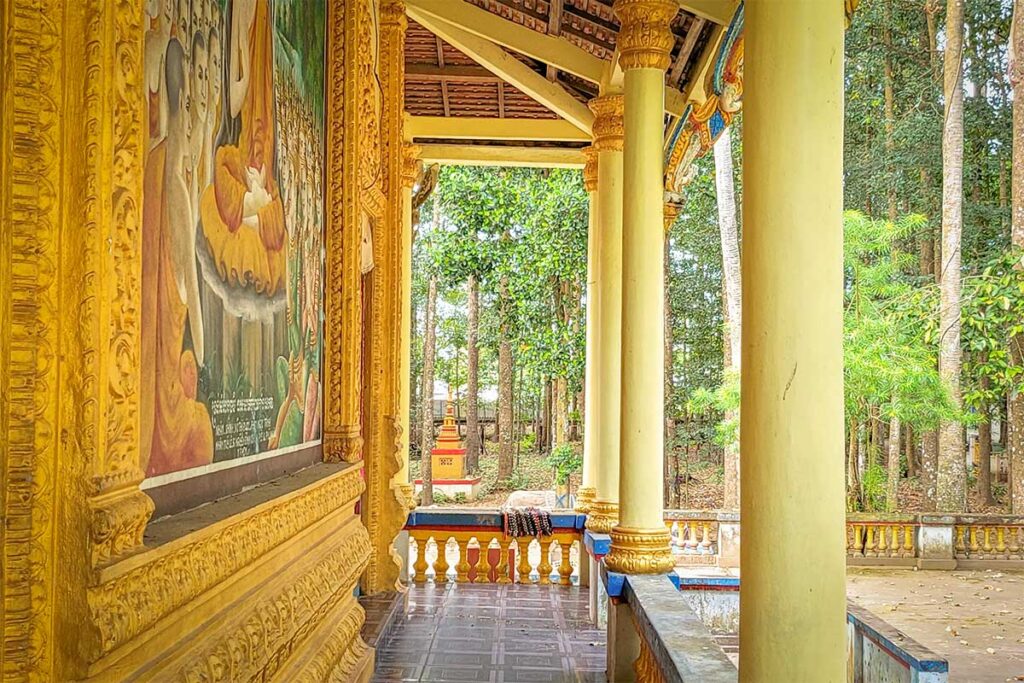
Culturally, Bat Pagoda plays an active role in Khmer Theravada Buddhism. Monks still live and study here, and the temple grounds host important Khmer festivals such as Chaul Chnam Thmey (New Year) and Sen Dolta (ancestor worship). Beyond its religious life, the pagoda is best known for its unusual residents—the giant fruit bats—as well as local legends like the tombs of the “five-toed pigs,” which add a layer of superstition and folklore to the site.
Highlights when visiting Bat Pagoda
1. Main hall architecture
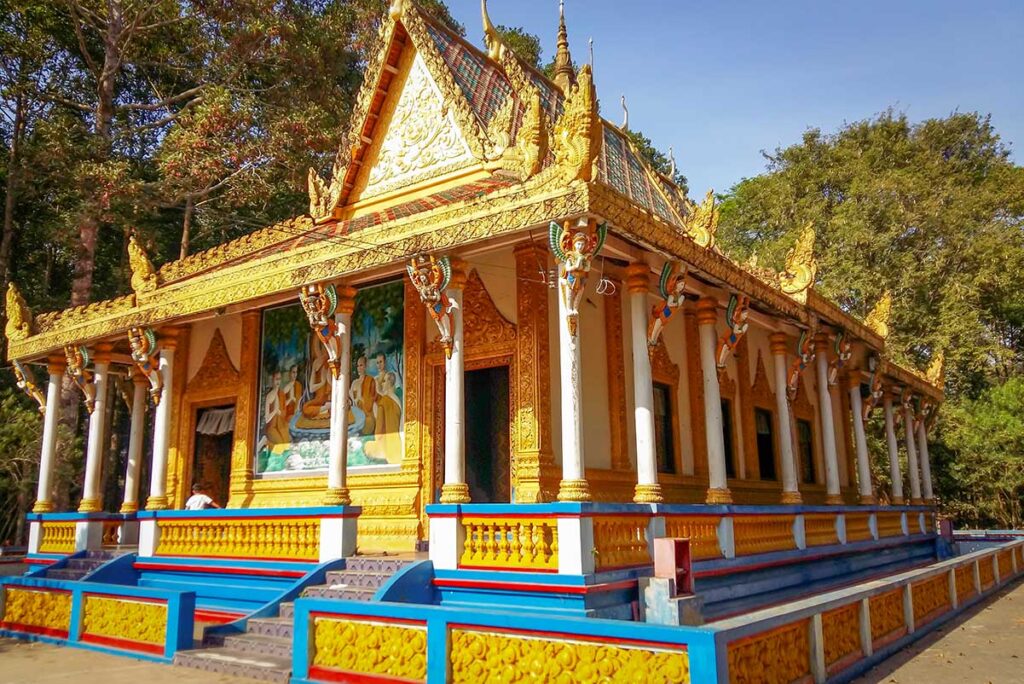
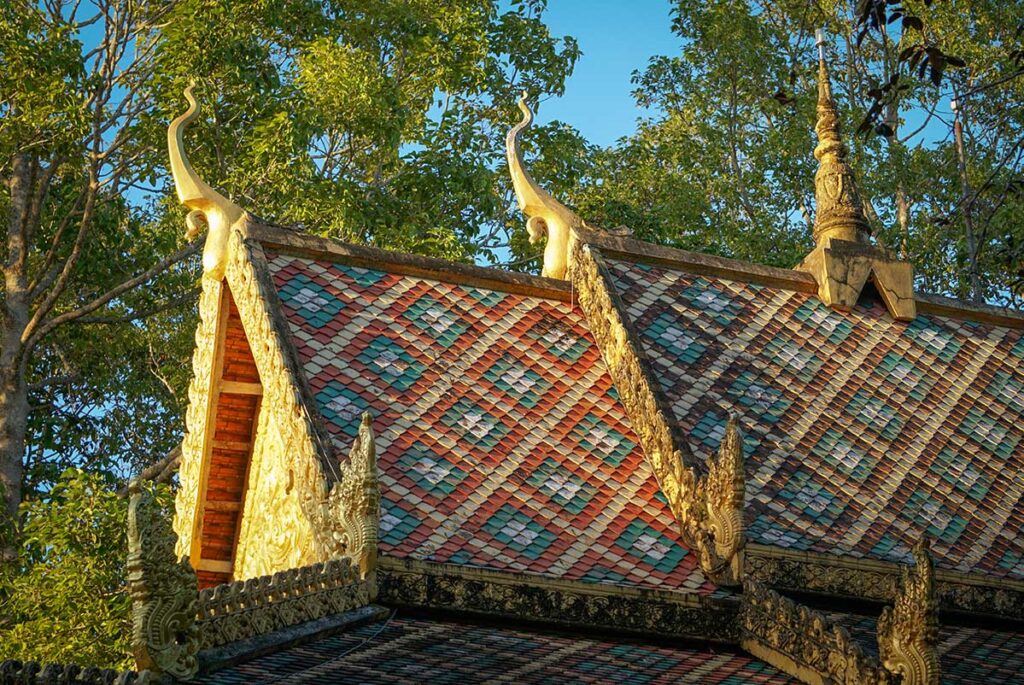
The main hall of Bat Pagoda stands on a raised foundation, with its roof corners curving upward into the shapes of naga serpents, a classic feature of Khmer temple design. The supporting columns are decorated with statues of Kemnar celestial maidens, hands pressed together in prayer.
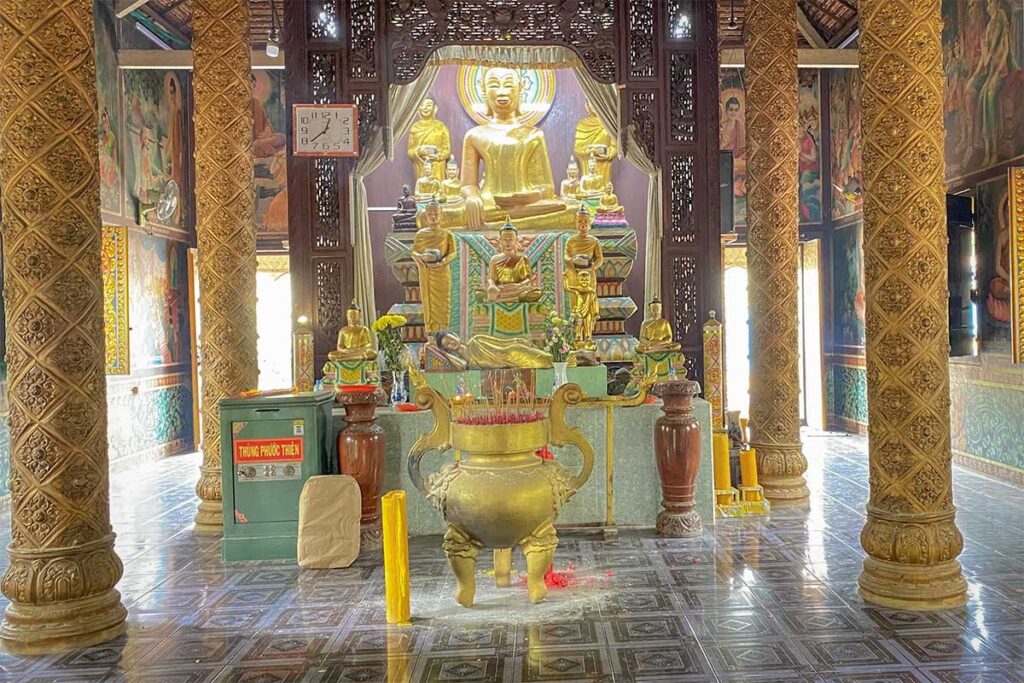
Inside, you’ll find a large stone statue of the Buddha seated on a lotus pedestal, as well as an image of the Buddha sheltered by the snake king Muchalinda. The walls are painted with scenes from the Buddha’s life, while rare palm-leaf scriptures are preserved as part of the pagoda’s heritage.
2. The sala and stupas
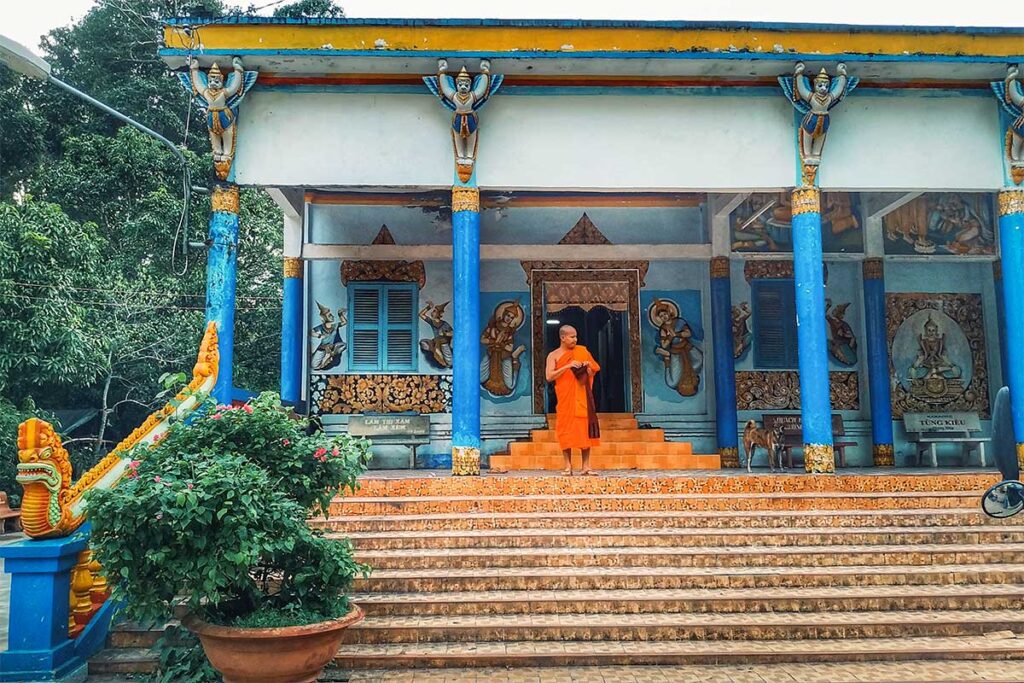
The sala, or meeting hall, is used for community and religious gatherings, reflecting the central role of the temple in Khmer Theravada Buddhism.
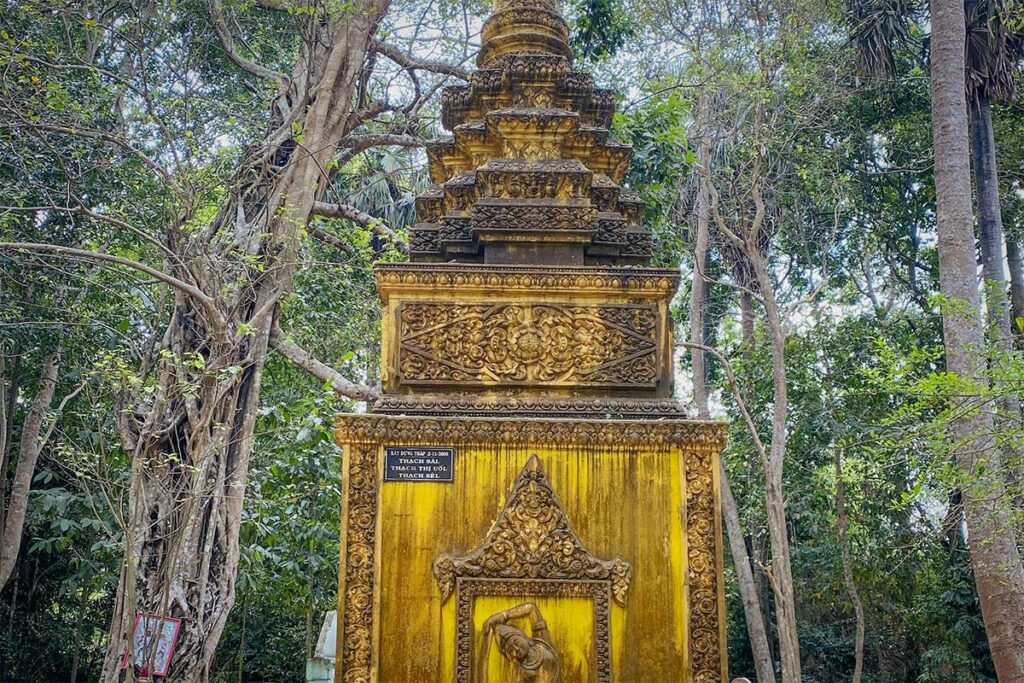
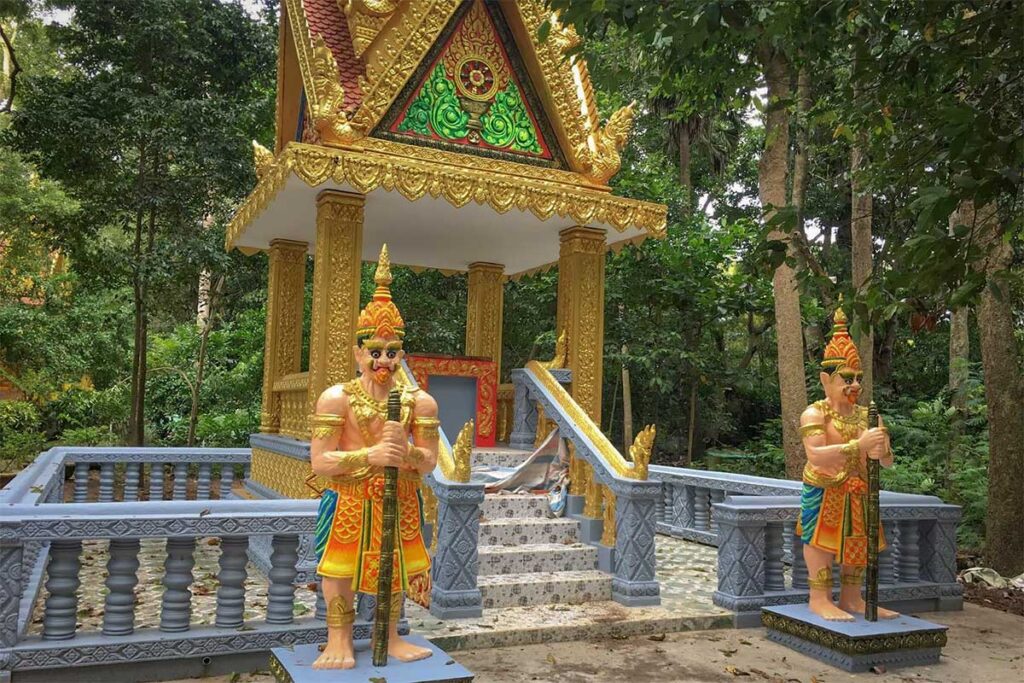
Scattered around the grounds are several stupas (chedis), which hold the ashes of past abbots. These stupas are not particularly large, but they carry spiritual weight for the local community and add to the layered atmosphere of the pagoda.
3. The bat colonies
The pagoda is most famous for its resident giant fruit bats, some with wingspans of up to 1.5 meters. During the day, they hang in clusters from the high branches, and at dusk they take flight to forage in nearby orchards. Visitors can usually spot them in the trees toward the back of the compound. However, it’s worth noting that the colonies are not as large as they once were, and the bats can be difficult to see clearly as they roost high up. Along with the sight, there is also the sound of their calls and, depending on where you stand, a noticeable smell—part of the reality of visiting a living colony.
4. Legends of the Five-Toed Pigs
Adding to the uniqueness of the pagoda is the legend of the five-toed pigs. Khmer people believe pigs born with five toes are “human spirits” and should not be slaughtered. In the past, such pigs were brought here to live out their lives, and after death, they were buried on the pagoda grounds. The tombs remain today, adding a touch of folklore and superstition that many visitors find intriguing.
5. Pagoda grounds & Atmosphere
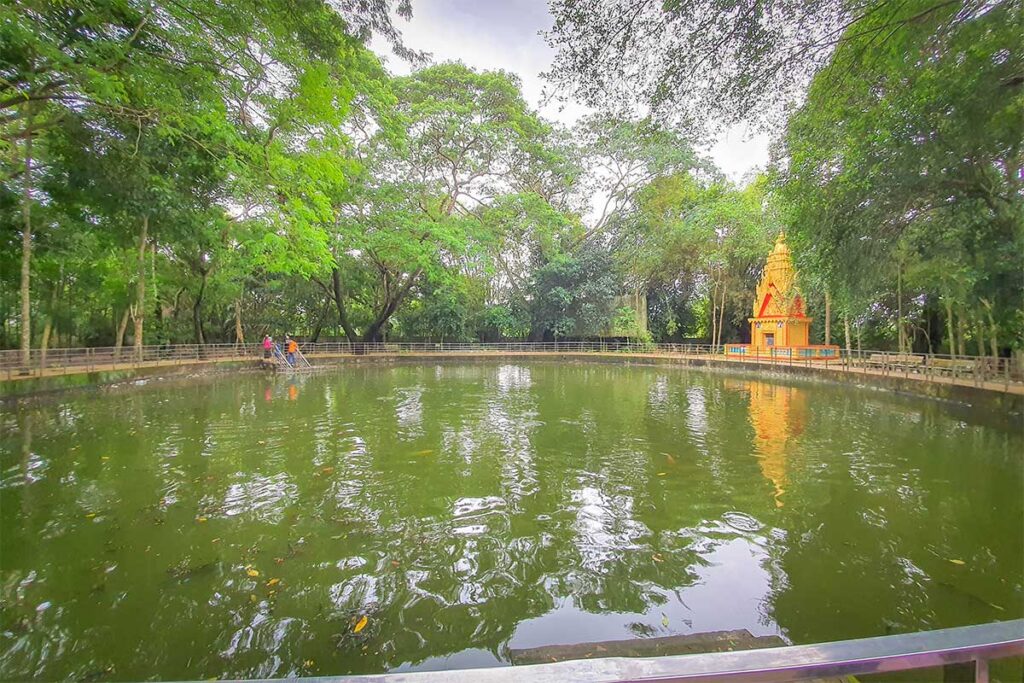
The compound is shaded by towering dipterocarp and star trees, which give the temple its tranquil character and provide the bats with shelter. Walking through the grounds, you’ll notice a mix of peace and activity—monks, locals, and the occasional tourist. On the honest side, reviews often mention that parts of the grounds can be messy with trash or that beggars sometimes approach visitors. Still, the pagoda retains a quiet charm, especially when you step away from the main entrance and into the shaded gardens.
Practical visiting information & Tips
Location & Getting there
Bat Pagoda is easy to reach, sitting just 2–3 km from the center of Soc Trang City. Follow Le Hong Phong Street, then turn onto Ma Toc Road for about 1 km to reach the entrance. A taxi or motorbike is the most practical way to get there, and the ride from downtown takes less than 10 minutes.
Opening hours & Entry
The pagoda does not have fixed visiting hours and is generally open all day. Entry is free, though small donations for temple upkeep are welcome.
Best time to visit
If you’re interested in the architecture and atmosphere, morning visits are calmer and cooler. For the bats, the most interesting time is late afternoon around dusk, when they begin to leave the trees in large groups to forage for food.
Dress code & Etiquette
As an active Khmer Buddhist temple, modest dress is important—cover shoulders and knees. Visitors should avoid loud behavior, and children should be reminded not to climb on statues of animals such as elephants and snakes, which hold religious meaning.
Facilities & Services
There is a parking area, but some visitors report issues with scams or aggressive attendants. If arriving by motorbike, it’s best to drive inside the compound to park rather than leaving your bike outside. Toilets are basic, and there are a few small shops nearby selling drinks and snacks.
Safety & Comfort
Bring mosquito repellent, especially if visiting around dusk. The Mekong Delta heat can be intense, so carry water and a hat. While the grounds are generally safe, some travelers mention the presence of beggars, which can be uncomfortable but are part of the reality here.
Bats
The giant fruit bats may look intimidating because of their size, but they are harmless to people. They feed only on fruit and spend the day resting in the trees. You’ll hear their calls and sometimes catch a strong smell beneath the trees, but there’s no danger in walking around the grounds. For the best chance to see them in flight, stay until dusk when they leave the pagoda to forage in nearby orchards.
Sights nearby Bat Pagoda
Soc Trang is one of the best places in the Mekong Delta to explore Khmer culture and architecture, with dozens of pagodas scattered around the city and surrounding countryside. If you’re planning a trip to Bat Pagoda, it’s easy to combine it with other sights in the area:
- Kh’leang Pagoda – A historic Khmer temple, considered one of the oldest in Soc Trang and known for its traditional wood-carved details.
- Clay Pagoda (Chùa Đất Sét) – A unique temple filled with thousands of clay sculptures and enormous candles that have been burning for decades.
- Chen Kieu (Bowl) Pagoda – A colorful temple blending Khmer and Chinese influences, decorated with broken porcelain bowls in its mosaics.
- Soc Trang Museum – A small but useful stop to learn about the province’s mix of Khmer, Chinese, and Vietnamese communities.
- Nga Nam Floating Market – One of the Mekong Delta’s most authentic floating markets, held at a five-river junction about an hour from Soc Trang city.
These places can be combined into a half-day or full-day itinerary, giving you a broader picture of Soc Trang’s cultural and local life beyond Bat Pagoda.
Is Bat Pagoda worth visiting?
Bat Pagoda is certainly worth a stop if you’re already in Soc Trang or exploring Khmer culture in the Mekong Delta. The mix of colorful Khmer architecture, spiritual significance, and the chance to see rare giant fruit bats makes it a unique experience you won’t find in most other places in Vietnam.
That said, it’s not a large or polished attraction. The bat colonies are smaller than in the past, and you may notice some litter around the grounds or be approached by beggars. If you’re mainly looking for a grand temple complex, you might find it underwhelming.
Overall, Bat Pagoda is best for travelers curious about Khmer traditions, unusual folklore, or wildlife encounters. If those aspects appeal to you, it’s a memorable and worthwhile visit; if not, you may prefer combining it with other nearby sights for a more rounded Soc Trang experience.
